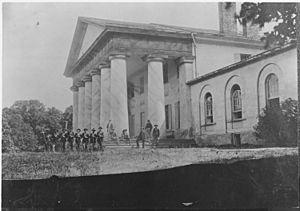Douglas Syphax facts for kids
Quick facts for kids
Douglas Syphax
|
|
|---|---|
| Born | 1842 Alexandria, Virginia, U.S.
|
| Died | 4 February 1890 |
| Nationality | American |
| Occupation | Property developer |
| Known for | Union Army officer during American Civil War |
| Relatives | Syphax family |
Douglas Syphax (1842 – 1890) was an African American man from Virginia. He served as an officer in the United States Colored Troops during the American Civil War. After the war, he moved to Philadelphia, Pennsylvania. There, he became a successful property developer. He was also active in the Grand Army of the Republic, a group for Civil War veterans.
Douglas Syphax was one of the few African Americans to become a sergeant in the US Colored Troops. This was a significant achievement during that time.
Family History

Douglas Syphax was part of the important Syphax family in Virginia. This family was given land in Arlington County, Virginia. This land later became part of Arlington National Cemetery.
The Syphax family had a unique connection to Martha Washington, who was the wife of President George Washington. The family's story begins with Mariah Custis. She was the daughter of George Washington Parke Custis. He was Martha Washington's only grandson. Mariah's mother was Ariana Carter, who was an enslaved person in the Custis household.
When Mariah Custis wanted to marry Charles Syphax, who was also enslaved by her father, George Washington Parke Custis freed them both. He even held their wedding at his Arlington mansion. As a wedding gift, he gave them fifteen acres of his estate. Mariah's white half-sister, Mary Custis, later married the famous Confederate General Robert E. Lee.
Mariah and Charles Syphax had ten children. Several of their children became important figures. For example, their oldest son, William Syphax, became the superintendent of Washington's black segregated school district.
Life and Work
Douglas Syphax was born in Arlington, Virginia, in 1842. In 1864, he joined the Union Army. He served for ten months and became a sergeant. He was honorably discharged from the army.
After his military service, Douglas Syphax moved to Philadelphia, Pennsylvania. Philadelphia was a city where many free African Americans lived since the Revolutionary War.
In Philadelphia, Douglas Syphax married Abbie McKee. Abbie's father was John McKee, a wealthy African-American businessman. John McKee had moved to Philadelphia from Virginia in the 1840s. He started as a waiter and later owned restaurants. He also invested in real estate and became very rich.
In the late 1800s, Douglas Syphax also started working in real estate. Philadelphia was growing, and many new people were moving there. He hired an African-American architect named Calvin Brent to design houses for him.
Douglas Syphax was a member of the Oliver P. Morton Post of the Grand Army of the Republic. This group helped Civil War veterans. Syphax was part of a committee that decided which veterans should receive help.
Douglas Syphax passed away on February 4, 1890. His wife, Abbie, lived until 1923. Because of Douglas's military service, both he and Abbie were buried in Arlington National Cemetery.
Douglas Syphax's Children
When Abbie Syphax's father, John McKee, died, he left Abbie $300. He also left $50 for each of her children. Her nephew, Henry McKee Minton, who later became a well-known doctor, also received $50. Most of John McKee's money was left to the Catholic Church to build a college for orphans.
However, John McKee's will was challenged in court. Abbie eventually received a much larger sum of $26,500 from her father's estate. When she remarried in 1904, she was considered one of the wealthiest African-American women in the city.
Douglas and Abbie Syphax had five children:
- Ernest Syphax became a pharmacist in Pittsburgh.
- Carrie Syphax Watson became the first Black director of domestic art in public schools in Washington, D.C.
- Mary E. Syphax and Julia Syphax Willis both became public school teachers.
- Theophilus John Minton Syphax attended Phillips Exeter Academy. He was friends with Roscoe Conkling Bruce, who later became an educator. When he was in his 20s, Theophilus changed his name to T. John McKee. He decided to live as a white person to avoid racial discrimination. He became a lawyer in New York City. He did not stay in touch with his family for a while. Later in life, after his siblings had passed away, he revealed his African-American heritage. He did this to claim a part of his grandfather McKee's estate that had not yet been given out.

